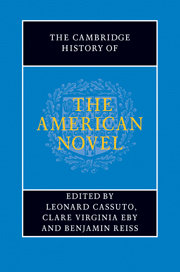Book contents
- Frontmatter
- General Introduction
- PART ONE INVENTING THE AMERICAN NOVEL
- Introduction: inventing the American novel
- 1 Transatlantic currents and the invention of the American novel
- 2 Susanna Rowson, Hannah Webster Foster, and the seduction novel in the early US
- 3 Charles Brockden Brown and the novels of the early republic
- 4 The novel in the antebellum book market
- 5 American land, American landscape, American novels
- 6 Cooper and the idea of the Indian
- 7 The nineteenth-century historical novel
- 8 Hawthorne and the aesthetics of American romance
- 9 Melville and the novel of the sea
- 10 Religion and the nineteenth-century American novel
- 11 Manhood and the early American novel
- 12 Sentimentalism
- 13 Supernatural novels
- 14 Imagining the South
- 15 Stowe, race, and the antebellum American novel
- 16 The early African American novel
- PART TWO REALISM, PROTEST, ACCOMMODATION
- PART THREE MODERNISM AND BEYOND
- PART FOUR CONTEMPORARY FORMATIONS
- A selected bibliography
- Index
5 - American land, American landscape, American novels
from PART ONE - INVENTING THE AMERICAN NOVEL
Published online by Cambridge University Press: 28 July 2011
- Frontmatter
- General Introduction
- PART ONE INVENTING THE AMERICAN NOVEL
- Introduction: inventing the American novel
- 1 Transatlantic currents and the invention of the American novel
- 2 Susanna Rowson, Hannah Webster Foster, and the seduction novel in the early US
- 3 Charles Brockden Brown and the novels of the early republic
- 4 The novel in the antebellum book market
- 5 American land, American landscape, American novels
- 6 Cooper and the idea of the Indian
- 7 The nineteenth-century historical novel
- 8 Hawthorne and the aesthetics of American romance
- 9 Melville and the novel of the sea
- 10 Religion and the nineteenth-century American novel
- 11 Manhood and the early American novel
- 12 Sentimentalism
- 13 Supernatural novels
- 14 Imagining the South
- 15 Stowe, race, and the antebellum American novel
- 16 The early African American novel
- PART TWO REALISM, PROTEST, ACCOMMODATION
- PART THREE MODERNISM AND BEYOND
- PART FOUR CONTEMPORARY FORMATIONS
- A selected bibliography
- Index
Summary
While “nature” has figured prominently in the aesthetic production of American identity, approaches to the natural environment have varied by medium and genre. Painters facing the problem of subject matter in the supposed thinness of American culture turned to nature to develop a national aesthetic during the antebellum era. Thomas Cole's sometimes nostalgic celebrations of wilderness as a special site of divine presence were reinterpreted in nationalist terms by the next generation of painters, who became known as the Hudson River school. These painters depicted optimistic narratives of the transformation of wilderness into cultivated space, while developing a visual culture in which a certain landscape form became identified as the national landscape. Their synecdochic nationalism presented nature' newness as symbolic of America's newness, the wilderness as ready to receive culture's imprint. Ironically, in transforming the wilderness, cultivation obliterated nature's newness and with it, the American promise of exceptionalism. Moreover, for all the Hudson River school's claims to aesthetic nationalism, their paintings originated in observations of a particular region's landscapes. This tension between aesthetic nationalism and local representation took a more complex form in the antebellum novel, where cultural narratives with claims to national scope, such as the pastoral retreat or the progress of civilization through stages of economic development, were inflected through or conflicted with local narratives and landscape forms.
In discussions of the prospects for a national literature, theorists of the novel were divided on the question of the thinness of American culture and its implications for setting as the ground of a distinct tradition.
- Type
- Chapter
- Information
- The Cambridge History of the American Novel , pp. 88 - 102Publisher: Cambridge University PressPrint publication year: 2011



